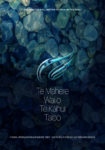
Te Whaitua Mo Te Whanganui-a-Tara Pepeha
A Traditional statement defining Te Whanganui-a-Tara region
No te kawa ora te mauri o te wai
From the ultimate life principles is the vitality of water.
Ka tupu te taurikura o ngā iwi, nga uri, ngā ruranga katoa
From this the nourishment of the iwi, their descendants and those who call this place home is provided.
Ko tātou katoa ngā tangata tiaki o ēnei wai!
For we all are the responsible guardians of these waters
Ngā wai o te Whaitua o Te Whanganui-a-Tara
The waters of the Te Whanganui-a-Tara
Whaitua E rere mai
Flow within the boundaries of
Turakirae ki Rimurapa Turakirae to Rimurapa Mai Rimurapa ki Remutaka
From Rimurapa to Remutaka Mukamuka ki Te Ra Whiti From
Mukamuka to Te Ra Whiti Pipinui ki te Ra Tō
To Pipinui across to te Ra Tō
Te Whanganui-a-Tara Whaitua Implementation Programme completed
A Committee of local people from Upper Hutt, Lower Hutt and Wellington was established in 2018. The 17-person Committee was co-chaired by Mana Whenua and a community member. They first adopted a set of kawa/principles to help drive their work and then set about developing a programme to restore wai ora (healthy water) for the next 100 years.
A Mana Whenua committee, Te Kāhui Taiao, was also created - comprising of representatives from Taranaki Whānui and Ngāti Toa Rangatira.
Two documents were produced which must be read, implemented and woven together to ensure the objectives and recommendations in both reports are met.
- Te Kāhui Taiao produced Te Mahere Wai, a Mana Whenua Whaitua Implementation Programme. It establishes Mana Whenua values, water quality objectives, and a Mātauranga Māori assessment framework (te Oranga Wai).
Te Mahere Wai o Te Kāhui Taiao

A Mana Whenua whaitua implementation plan to return mana to our freshwater bodies. Read more here

date_range Published 01 Nov 2021
Download now (PDF 4.6 MB) get_app- The full committee produced Te Whanganui-a-Tara Whaitua Implementation Programme.
Te Whaitua te Whanganui-a-Tara Implementation Programme

In 2019, the members of the newly established Whanganuia-Tara Whaitua Committee from Wellington, Upper Hutt and Lower Hutt, accompanied by Greater Wellington (Greater Wellington Regional Council) Councillors and staff members,… Read more here

date_range Published 01 Nov 2021
Download now (PDF 4.6 MB) get_appInteractive catchment map and information
- When we launched the WIP, we built a website sharing detailed information about the catchments. This includes interactive maps, photos, and water health targets. Check out this handy tool
- To jump straight to sub-catchment information, follow these links:
- Te Mahere Wai recommendations
- Whaitua Implementation Programme recommendations
Whatiau Te Whanganui-a-Tara Reference Group Terms of Reference 2022-2025


date_range Published 05 Jul 2023
Download now (PDF 130 KB) get_appGet in touch
- Phone:
- 0800496734
- Email:
- info@gw.govt.nz
